
A pine forest near Dubnitz.
The nature of Oceana is very diverse and is one of the key reasons tourists come to visit the state, together with its history and culture. Oceana's natural areas mainly consist of vast pine forests, although there is a lot of regional variation, such as swamps, mountainous terrains, and even natural meadows and heathlands. The countryside is hilly in the center of the state, but more flat near the coast.
It is the Oceana State Department of Environmental Affairs's task to regulate Oceana's nature and ensure its preservation for future generations.
Geography[]
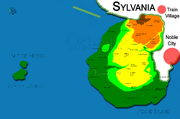
The names of the geographical regions in Oceana.
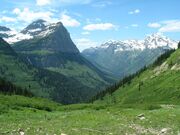
View over That Pitte, showing large meadows alternating with areas covered in pine forests.
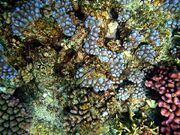
Biodiversity in the Oceana Reef.
The countryside is very flat near the sea where it is bordered with the Oceana beach. This area is called the Pacific Plains. Further land inwards, there is a hilly area which is called the Central Hill Land and totally in the north is a mountainous area which is rockier than the other areas, the Emerald Highlands. Every one of these areas have there own unique flora and fauna, because the areas have different soils and terrains.
There are also several rivers like the Barstow River, the Hurbanova Stream and the Beaver River. Along these rivers, small agricultural fields are located. These fields are in general old and are protected by local farmers to prevent them from becoming covered with buildings. Most of the fields along the river are used for cattle breeding. Other areas that are suitable for agriculture including the areas near Hurbanova, south of the Hurbanova Stream and especially along the dunes, as well as the Thatrensh and That Logue valleys in the East Hills canton, in which the hamlet of Boynitz is located. This last area is mainly used for field crops. The area along the Beaver River is very fertile, but not well-exploited because of natural concerns and the surplus of suitable agricultural land elsewhere in Lovia, near more inhabited places. Lastly, there is the Oceana Wine Region of which Righow is the capital. This area forms the southern edge of the Oceana hill lands and the soil is relatively poor, but very suitable for the production of grapes.
With regards to the natural environments in Oceana, one can separate several different areas. In the northeast of the state lies the Emerald Highlands which are very rocky and have a mountainous environment and ecosystem. This area is hardly touched by the human hand and as a result has a rich nature that is protected by the State Government. In the Central Hill Land forms another environment which mainly consists of pine forests, such as the Birds Forests, and covers the largest part of the state, including many of the northern geographic massives. While there is small-scale agriculture, mainly corn fields and vineyards, in the nothern and central part, it is only the southern part that is well-developed for grape production. In Southern Oceana lies a huge area that is covered with the Ryshembrock Forests. The area is protected from the sea by a long stretch of beaches and dunes, but tends to be relatively flat otherwise. Southern Oceana is very comparable to the North Coast district, although the latter has more agricultural traits, especially corn fields and farms, and is more hilly in several areas. The North Coast district is also the only area in Oceana where there is an abundance of heath.
Two very special areas to which access is restricted are the very vulnerable Svolnick Moor and the City Archipelago, the former is the largest swamp in Lovia and extremely wet compared to other places in Oceana. The swamp is only accessable from Dien Village, but usually it is recommended against coming to the swamp as its biotope is very vulnerable and the swamp can be dangerous too. The latter consists of two islands: the Isle of London and the Isle of Frisco, which both have very diverse ecosystems and are protected by the national government.
Areas that are more visited are the Oceana Reef, which is a unique environment in Lovia and contains rare coral, plants, crabs and fish, and Lake Vizzock in That Pitte, a common retreat for campers.
The area near the Beaver River Mouth is one of the most fertile areas of Lovia, and is one of the agricultural centers of the state.
Soils[]
Oceana soil has a tendency to be relatively dark, especially in the coastal areas. These areas mainly consist of umbrisol and chernozem soils, which are relatively suitable for human development. Deeper land inwards to the hills it becomes more brown and is the soil rich in organic materials, the so-called kastanozem, and in the Emerald Highlands the soil is grey, plinthosol, even though they are mostly covered with rocks, making the area very unsuitable for agricultural purposes. The southern area of Oceana used to be swamp terrain and as a consequence, the soil there is histosol, which is very rich in organic materials and is very useful for both fuel and intensive agriculture.
Flora[]
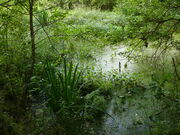
Vegetational diversity in the Svolnick Moor.
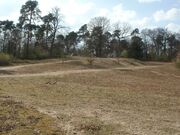
Shrubs, pine trees, and oaks in the Oceana dune landscape.
The most common tree of Oceana is the Oceana pine tree (Pinus sylvestris var. oceana), which also is a one of the state symbol of Oceana. A large part of the Central Hills and almost the whole coastline are covered by this trees. Loaf trees are very rare in Oceana and most of them have been introduced by mankind as an exotic species, except for in the marshy southern part of the state, where they form the majority of the tree species. Apart from trees, Oceana has a lot of diversity when it comes to fern and grass species. Flowering plants are comparatively rare, even compared to other Lovian states, and the majority of them only occur on the higher Emerald Highlands and along the Beaver River near the Sylvanian border. The Emeralds themselves form their own botanic region, with large parts of it covered in low-growing shrubs, grasslands, and moss. Another relatively excentric region is That Heye near Dubnitz, which is one of the few heathlands of the nation, and the only such in Oceana. As a result, unique plants exist here.
As mentioned before, Southern Oceana has a lot of exceptional plant species and breaks the rule of the pine forests. It should be noted however that a large part of Southern Oceana, especially the higher grounds, grounds adjacent to the dunes, and areas more located to the west of the state, are still almost exclusively covered in pine forests. The southern and eastern parts of the region, near the Beaver River, with a special mentioning of the Svolnick Moor, form the real exception. Especially this swampy area is a real gem when it comes to rare species, such as konermach. While there are more wetlands in Lovia, the Svolnick Moor is the only one of this type that does not experience direct influence from the sea and therefore has had its unique evolution to the swamp it is today.
The Oceana dunes are mainly covered with grass lands. At the transitional zones from dune to forest, pine trees are the most common trees. Furthermore, shrubs are common, as well as the English oak (Quercus robur), that has been introduced from Europe. Further inland, the type of vegetation depends on the region. In the North Coast area, mixed forests are more common, while in Southern Oceana, pine forests can be found. The Oceana Beach itself borders pine forests where there are no dunes, like in That Pynt.
Fauna[]
The Oceana fauna is very diverse. One notable thing is the lack of any native mammal species on the land, but many species were introduced later on by European immigrants. Nowadays, there live rabbits, squirrels, mice, and several other feral lifestock animals (diches) in the area. Most fauna consists of amphibian and reptile animals. There are also fish and arthropods and by the beaches several other animals. In sea, there is a variety of species, especially near the Oceana Reef. The only common mammal in the area lives out in the ocean, Hlond's whale.
Apart from insect species, there are just a few species that are restricted to mainland Oceana. Most animal species that are prominent in Oceana, can also be found in adjacent areas in Sylvania or on the City Archipelago.